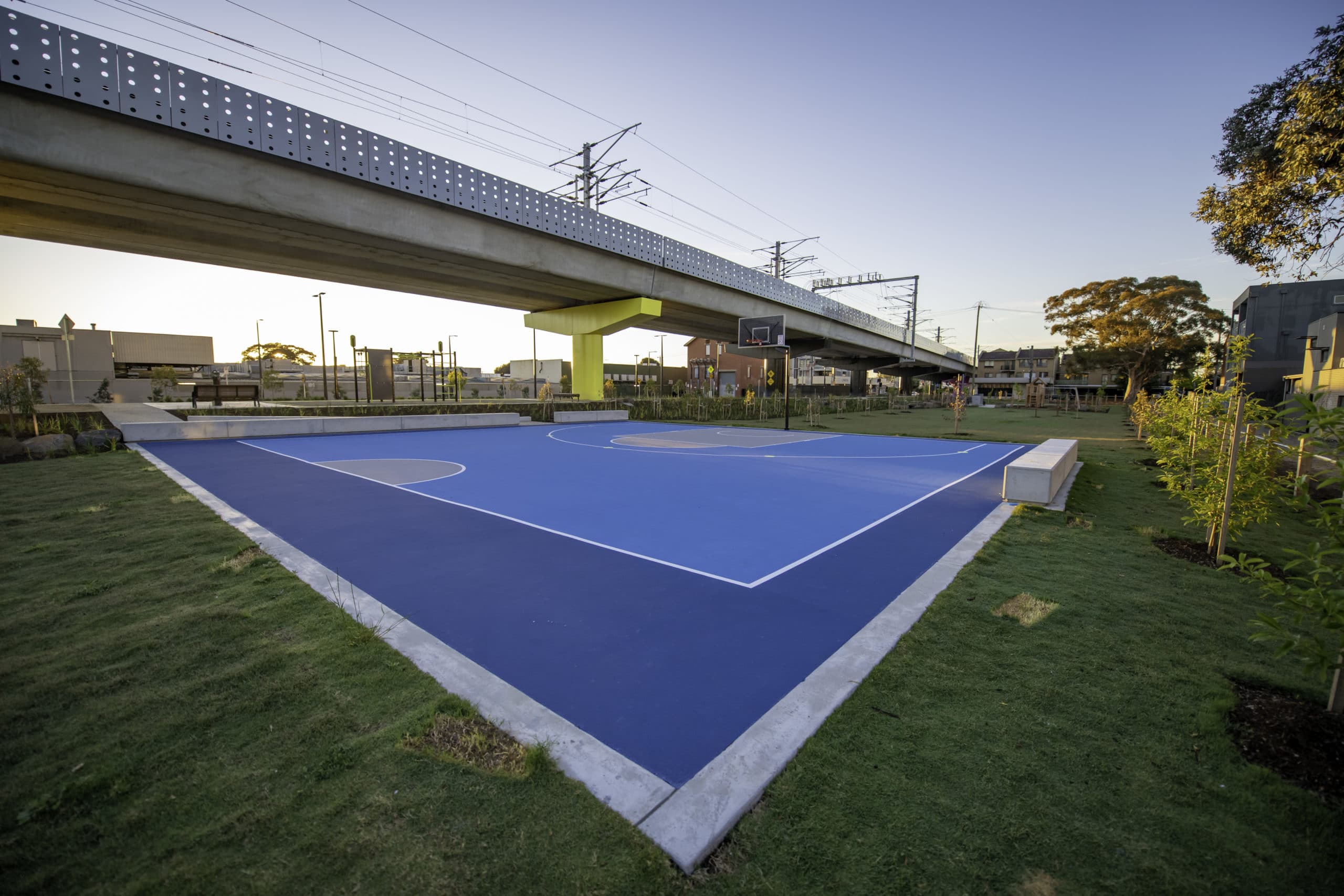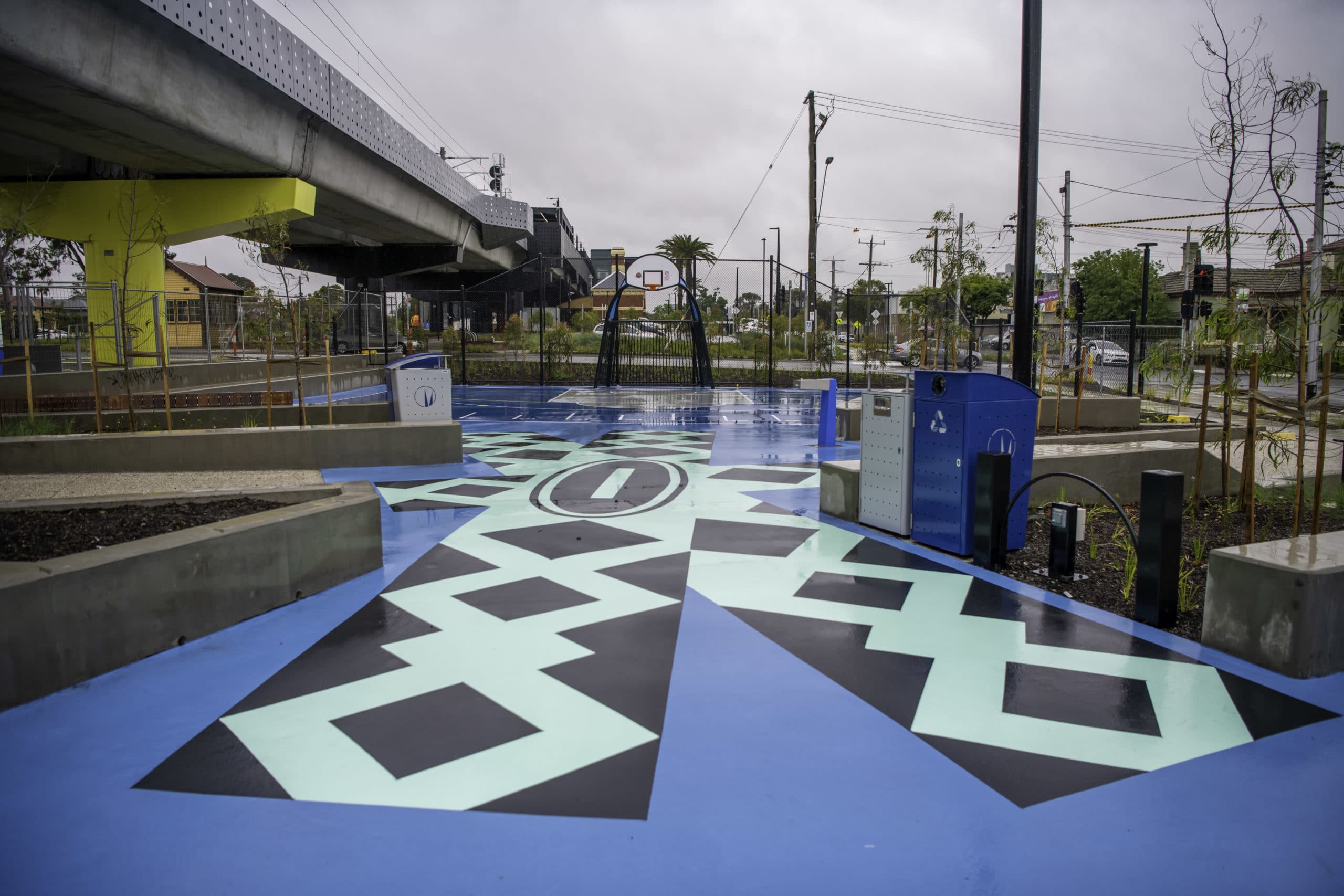Project Description
The Bell to Moreland (B2M) Level Crossing Removal Project was part of the wider Level Crossing Removal Project's (LXRP) program of works to remove 85 of the most dangerous and congested level crossings across Melbourne by 2025. Through the B2M Project, four level crossings were removed at Bell Street, Munro Street, Reynard Street and Moreland Road, and replaced with a rail over road solution. This included the construction of a continuous elevated rail structure along the length of the corridor, a modified station at Moreland, and a new premium station at Coburg. A new urban precinct was constructed under the viaduct to serve the local community, and this included the construction of pedestrian and cycle paths to enable active transport. The project was also designed to reflect and incorporate the heritage and local character of the area. The project was delivered by the North Western Program Alliance, which is made up of LXRP, John Holland Group, Kellogg, Brown & Root, and Metro Trains Melbourne.
Key Achievement
The Project delivered more than just built-to-standard infrastructure by implementing a 'place-based' design approach to create a vibrant urban precinct in the corridor under the new rail viaduct. The overall result was the provision of 58,000m2 (an area larger than two MCGs) of public space which opens onto parkland at both ends of the corridor, and the new 2.5km long Upfield Cycling Path. The new precinct area also includes public sporting facilities, public art installations, a fenced-off dog park, public barbecues, playgrounds, and outdoor furniture. Substantial new open and connected spaces along and adjacent to the rail corridor were designed with key stakeholder and community needs and input at the forefront using co-design processes. As a result, this new precinct transformed movement and place within the local area. The new precinct benefits the wider community from both a health and environmental perspective, promoting active recreation, inclusion, and a sustainable connection to nature.
Highlight 1
Ecology – 103% enhancement of ecology · Elevating the railway (rail over road design) enabled previously highly disturbed land in the rail corridor to be reclaimed and transformed into landscaped green areas. · Selection of the native planting palette reflected the local ecology and enhanced habitat. Canopy planting also created better habitat connectivity along the rail corridor. · Water Sensitive Urban Design (WSUD) was implemented to further improve ecological value and resilience to climate change. · Woody Meadows (Victorian First) – The Woody Meadows Project seeks to serve as a low maintenance landscape solution that centres around Australian shrubs. This decrease in maintenance and irrigation requirements represents cost savings and environmental benefits. The Bell to Moreland Project was one of the first projects to adopt this initiative.
Highlight 2
Energy – 53% reduction in GHG emissions · Construction savings through optimising construction practices to reduce project program. Solar and biodiesel powered equipment and site sheds. · Operational savings through reduction in building footprint, and installation of energy efficient fixtures and fittings and 21kW of solar panels.
Highlight 3
Indigenous Co-Design - Victorian First NWPA created a strategy for Indigenous Co-Design on the B2M Project. This included regular and ongoing input into the design principles by Traditional Custodians of the country. This was enabled through facilitation and engagement with the NWPA's project team and the specialist heritage consultant. As part of this, NWPA has developed program-wide Aboriginal Design Principles and established an Aboriginal Reference Group with Wurundjeri Traditional Owners to discuss and find solutions to integrate cultural principles into the design process. This resulted in outcomes that go above and beyond business-as-usual practices, by creating safe and culturally relevant spaces for traditional custodians to utilise. Specifically, the co-design process led to a yarning circle at Moreland Station. These principles and guidelines have contributed to broad state market transformation in sustainable development and other Alliances have adopted this Indigenous Co-Design Initiative.
Acknowledgment
The B2M Project has been acknowledged as achieving a series of Australian-first innovations:
- eMesh (Australian First) – 100% recycled fibres replace steel reinforcement across a variety of concrete structures. These fibres serve to mitigate crack propagation as they provide enhanced ductility to concrete elements. The Bell to Moreland LXRP installed emesh across footpaths as well as shared-user paths. This incorporation alone saw emesh replace 712 SL72 mesh sheets and experience savings equating to nearly 90 tCO2eq.
- Remote concrete maturation monitoring (Australian first) - Existing methods of testing concrete curing are time intensive processes. The B2M Project sought to rectify these issues and provide an innovative way to assess concrete maturity.The solution came in the form of the 'Digital ConXsensor', a low-cost, low-power, wireless mesh network technology. Sensors are able to measure strength in-situ by correlating concrete temperature to strength. These sensors see data transmitted remotely every five minutes. This allows concrete maturity to be assessed in near real-time and the program to progress at the fastest pace possible. These sensors were installed in 250 structures at approximately 400 locations across the project.
- The 1500V DC Electrol Remote Isolation Switch was first utilised in the Bell to Moreland (B2M) Works Package where it provides a cost effective alternative to either a substation or tie station. The idea to produce this Remote Switch has emerged a few times, however the concept is highly complex which made it difficult to achieve. The switch can be remotely controlled by Electrol (MTM's Electrical Systems Control Centre) to isolate power in certain sections along the tracks. It can also be adopted in the future to replace manual switches found in various locations across different projects. That being the case, the Remote Switch carries significant cost and time savings. This feat has never been accomplished before in this magnitude for this purpose in Australia and is considered a ground-breaking initiative which can be applied in LXRP projects or industry-wide and shows significant contribution in Commercial, Engineering and Design and Sustainability aspects.
Project Details
- Project Owner: LXRP
- Rating Type: As Built
- Project Start Date: September 2019
- Practical Completion Date: November 2021
- Certification Date: June 2022
- Location: VIC Key
- Stakeholders: John Holland, KBR, MTM, Level Crossing Removal Project
Project Website
To find out more information about this project, visit:
https://levelcrossings.vic.gov.au/







